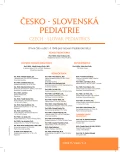Bonding support after child birth
Authors:
L. Mazúchová 1; S. Kelčíková 1; P. Vasilková 1; J. Buchanec 2
Authors‘ workplace:
Ústav pôrodnej asistencie, Jesseniova lekárska fakulta UK, Martin, vedúca doc. Mgr. M. Bašková, PhD.
1; Klinika detí a dorastu, Jesseniova lekárska fakulta UK a UNM, Martin, prednosta prof. MUDr. P. Bánovčin, CSc.
2
Published in:
Čes-slov Pediat 2016; 71 (4): 196-201.
Category:
Original Papers
Overview
Bonding represents bio-comfort for mother as well as for child. The aim of this study was to find out the experience of women with bonding support after child birth, as well as to recognize if the presence of accompanying person during child birth has a impact on bonding support.
Methods:
As an explorative method, we have used a questionnaire of its own construction. The questionnaire was focused on the detection of bonding support after child birth. 2001 Slovak women have participated in this study (age 30.0 ±5.34 years). In order to statistically process the data, we have used one-dimensional descriptive statistics and „Chi-quadrat“ test.
Results:
The direct skin to skin after child birth touch was not made possible for 55% respondents. 31.6% of women were enabled to lay their child skin to skin, however just for a short period of time, most frequently between 1 to 5 minutes (27.1%). This could be considered as only a partial bonding support. Bonding was supported only by 20.3% respondents. We have ascertained statistically significant influence of accompanying person during child birth (Chi2=47.340, p<0.000005) on bonding support after child birth.
Conclusion:
The conclusion of our study refers to the inconvenient fact that support of bonding after childbirth has proved to be insufficient. Gained results could be contributive to requirements argumentation for opening a new attitude towards the norm and needs of mother and child in relation to all routine interventions of medical personnel. Bonding support after child birth means realization of physiological way of child care and fulfillment of biological, psychological and social needs of both mother and newborn.
Key words:
bonding, bonding support after child birth, immediate contact between mother and child, skin to skin touch
Sources
1. Vestník Ministersva zdravotníctva SR čiastka 54–55, z 20. novembra 2009, normatívna časť 56 – Odborné usmernenie o podpore výživy doj-čiat a batoliat dojčením. MZ SR 2009: 404.
2. World Health Organization and Unicef. Original BFHI Guidelines developed. 2009.
3. World Health Organization. Evidence for the 10 Steps to Successful Breastfeeding. Geneva: World Health Organization, 2007.
4. Bašková M. Metodika psychofyzické přípravy na porod. Praha: Grada Publishing, 2015: 106–108.
5. Bystrova K, et al. „Early lactation performance in primiparous and multiparous women in relation to different maternity home practices. A randomised trial in St. Petersburg.“ Int Breastfeed J 2007; 2: 9. doi: 10.1186/1746-4358-2-9.
6. Charpak N, et al. Kangaroo mother care: 25 years after. Acta Paediatricia 2005; 5: 514–522.
7. Moore ER, et al. Early skin-to-skin contact for mothers and their healthy newborn infants. Cochrane Database Syst. 2012 May 16; 5:CD003519. doi: 0.1002/14651858.CD003519.pub3.
8. Mrowetz M. Bonding: Porodní bolest - porodní radost. Unipa, 2010.
9. Hašto J. Diskusia o význame popôrodného kontaktu matky a dieťaťa. Psychiatria, psychoterapia, psychosomatika 2014; 2: 39–41.
10. Fendrychová J, Borek I, et al. Intenzivní péče o novorozence. 2. vyd. Brno: Národní centrum ošetřovatelství a nelékařských zdravotnických odborů, 2012: 51–53.
11. FIGO Guidelines. Mother-baby friendly birthing facilities. International Federation of Gynecology and Obsterics, International Confederation of Midwives, White Ribbon Alliance, International Pediatric Association, World Health Organization. International Journal of Gynecology & Obstetrics 2015; 2: 95–99.
12. Bašková M, et al. Inovácia obsahu, foriem a metód na podporu praktických zručnosti v pôrodnej asistencii. 1. vyd. Martin: JLF UK, 2015: 152–180.
13. Mrowetz M, Peremská M. Podpora raného kontaktu jako nepodkročitelná norma – chiméra, či realita budoucnosti? Pediatr Praxi 2013; 3: 201–204.
14. Miklovičová D, Poloková A, et al. Celoslovenská analýza podpory dojčenia v pôrodniciach. Výsledky prieskumu. MAMILA, o. z. 2015: 1–23.
15. Dekker R. Can Hospitals Keep Moms and Babies Together after a Cesarean? Evidence Based Birth, 2013.
16. Sázavská A. Podpora „Bondingu“ po cisářském řezu. Bakalářská práce. Brno: LF MU, 2013: 52–53.
17. Bánovčinová Ľ, Bašková M. Sources of work-related stress and their effect on burnout in midwifery. Procedia-Social and Behavioral Sciences 2014; 132: 248–254.
18. Mrowetz M, Chrastilová G, et al. Bonding – porodní radost, Podpora rodiny jako cesta k ozdravení porodnictví a společnosti? Praha: DharmaGaia, 2011: 100–105.
19. Watson J. Caring science as sacred science. Philadelphia: FA Davis Company, 2005.
20. Nolan M. Preparation for birth and beyond: our health and wellbeing. Pract Midwife 2012; 7: 20–21.
21. Repková A, Padyšáková H. Sprevádzajúce osoby pri pôrode. Ošetrovateľský Obzor 2007; 1–2: 33–35.
Labels
Neonatology Paediatrics General practitioner for children and adolescentsArticle was published in
Czech-Slovak Pediatrics

2016 Issue 4
- What Effect Can Be Expected from Limosilactobacillus reuteri in Mucositis and Peri-Implantitis?
- The Importance of Limosilactobacillus reuteri in Administration to Diabetics with Gingivitis
Most read in this issue
- How to assess high-sensitive troponin T in newborns?
- Current perspectives on inherited bone marrow syndromes
- Rectal suction biopsy in clinical practice
- Bonding support after child birth
